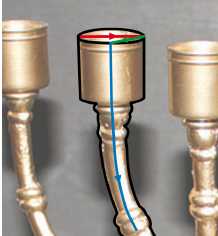| 3-Sweep - 3D Models From Photos |
| Written by Mike James | |||
| Monday, 16 September 2013 | |||
|
3-Sweep looks like magic. You draw a few simple shapes which automatically snap to the object outlines in the photo, drag a few things and you have a complete, textured model that you can manipulate within the photo. If you have tried your hand at photo editing, you will know that it is an essentially 2D process. You might see the photo as a 3D scene but the editing tools work with the 2D patches of color that make up the photo. You can do easy things like painting over objects with a background texture or removing parts of objects, but what you can't do is turn an object around, so that it faces another direction, or move the object within the scene. You could do this if the objects you recognized in the photo were true 3D models. 3-Sweep is a new approach to the problem that makes use of human intelligence with a little clever image processing to build 3D models that you can then edit within the photo in much more sophisticated ways than the 2D approach allows. 3-Sweep makes use of the observation that most 3D objects are extrusions - i.e. obtained by sweeping a 2D shape along a 3D line. You might think that this is restrictive, but by varying the size of the shape you can create complex objects. The main restriction is that the objects are symmetrical in cross section.
3-Sweep allows a human to draw cross sectional shapes - an ellipse say, that defines two dimensions of the object. Next a path is drawn on the photo which sweeps the cross sectional shape down the object to create a 3D model. The trick to making it easy is that the draw shapes snap to outlines in the photo. If you have used image editing software you will probably already know about magic selection tools that automatically follow edges that you identify. This works in much the same way. As the outline is swept down the object it automatically adjusts its size to fit. The software also can impose constrains such as parallelism and even snap complete models to a different part of the photo. All of this makes it very fast to create surprising complex and realistic models. You need to see the video to see how it all works:
There are a few things to notice - the main one is that parts of the video are speeded up and it is difficult to judge what the real editing speed would feel like. However, this is a small matter as video processing gets faster every week. It is also good to notice where the technique gets it wrong. The examples at the end of the video are almost more interesting than the impressive examples at the start. As well as being a way to edit photos in new and radical ways you can also see that this has other possibilities in connection with technologies such as VR and 3D printers. More Information3-Sweep: Extracting Editable Objects from a Single Photo
Related ArticlesVuforia & PrimeSense Capri Bring Depth To VR Kinect Fusion Coming to the SDK
To be informed about new articles on I Programmer, install the I Programmer Toolbar, subscribe to the RSS feed, follow us on, Twitter, Facebook, Google+ or Linkedin, or sign up for our weekly newsletter.
Comments
or email your comment to: comments@i-programmer.info
|
|||
| Last Updated ( Monday, 16 September 2013 ) |


